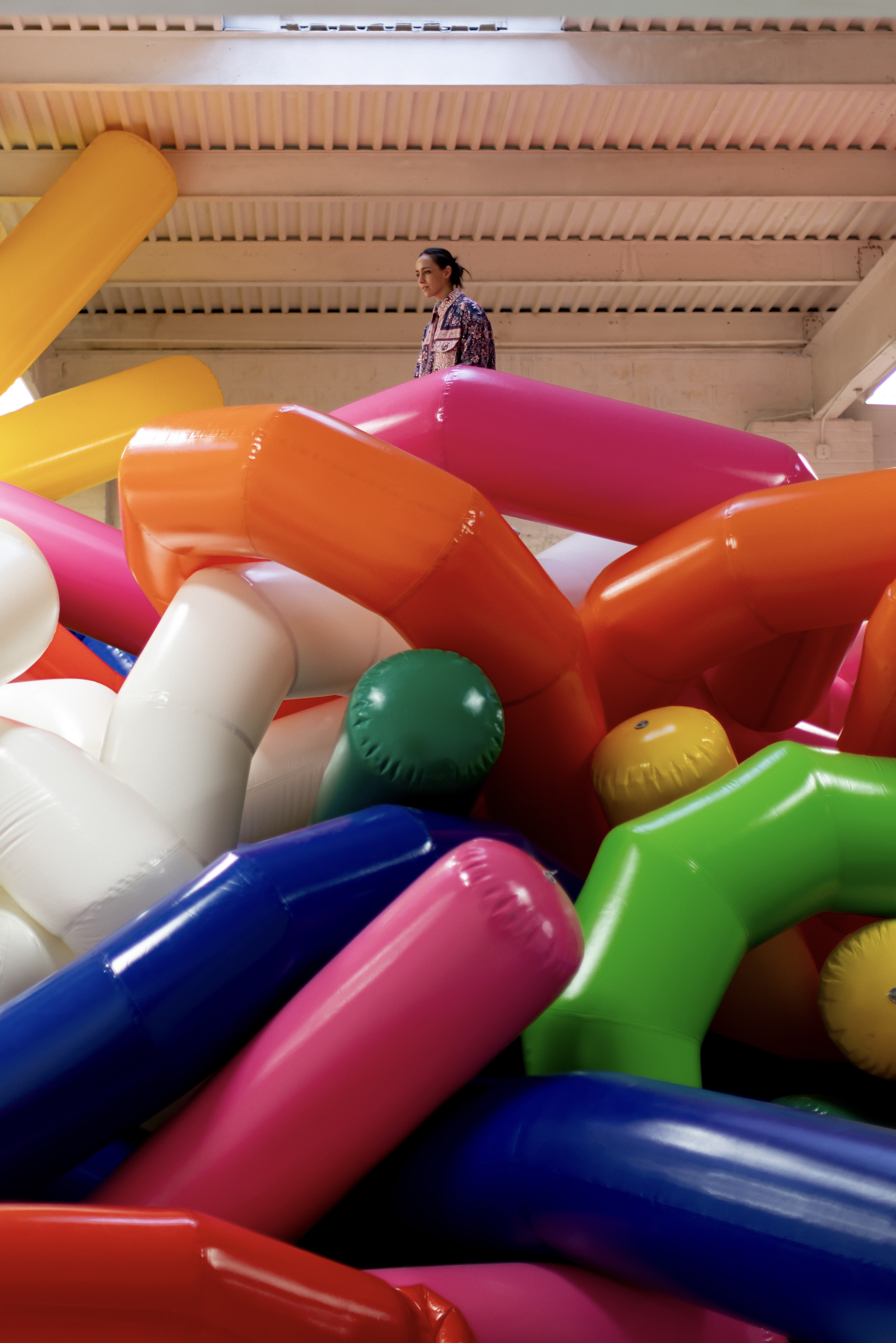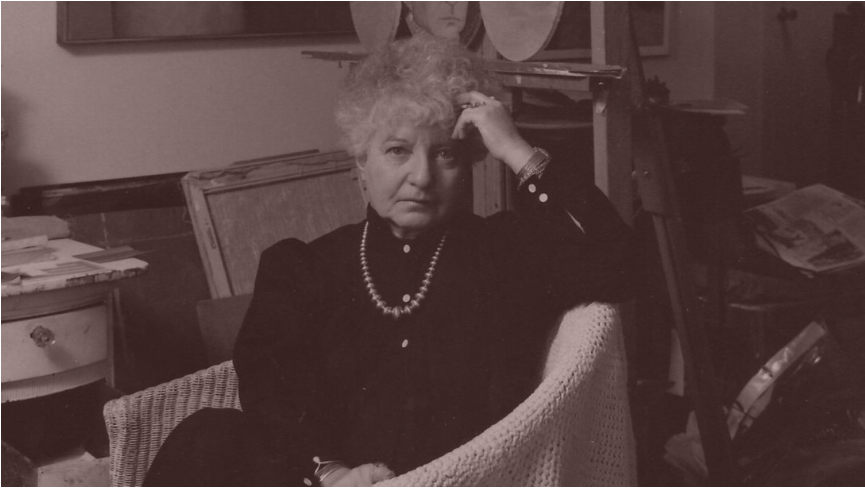Welcome back to Wall Power. I’m Marion Maneker.
Tonight, I’m
going to take you behind the scenes of a fascinating new show, The Human Situation: Marcia Marcus, Alice Neel, Sylvia Sleigh, which opened last Thursday at Lévy Gorvy Dayan—the uptown gallery run by some of the art world’s most wired dealers. As I’ve been saying for some time, the market is taking a turn toward the rediscovery of historic and previously underappreciated artists. This show is part of that process, but it also cleverly incorporates contemporary artists. More on all of that below. Plus, I’ll introduce you to the collector who’s playing an important role in bringing it all together.
|
|
|
A MESSAGE FROM OUR SPONSOR
|
The first steps towards a masterpiece starts with a dream. The all-electric BMW i7 – the
evolution of brilliance. Learn more at
BMWUSA.com
|
|
|

|
Julie Brener Davich
|
|
Cj Hendry, Keff Joons (2025). Photo: Courtesy of Cj Hendry Studio
|
Cj Hendry, the Australian expatriate artist and entrepreneur, went to
school for neither art nor business—she dropped out of college, in fact—but she wound up with a knack for both. Not only can Hendry draw pixel-perfect pencil renderings, but she’s built up a formidable social following (866,000 and counting on Instagram) and knows how to create commercial pop-ups—like her shoppable, sequined Bargain Bodega in Williamsburg—that engage
the crowds.
Her team’s current project, Keff Joons, debuted in a former storage facility in Dumbo last week, and runs through Sunday. The 14-foot-tall climbing structure, made from 50 balloons, each 25 to 35 feet long, is an installation, or activation, or whatever the current word is for an art show-slash-playground.
If you want any of the art displayed in the venue—eight original drawings of mini balloon “scribbles” priced at $48,990 each, or a $220,000 drawing or
$85,000 sculpture, both of a balloon knot—you’re out of luck. They’re all sold. (There are, however, 10 framed lenticulars, also of balloon knots, in editions of 100, priced at $790 each and available on her website starting at 7 p.m. ET on Thursday.) Altogether, the artworks alone add up to almost $1.5 million. The experience itself is free, as are the branded orange grippy socks and Tony’s Chocolonely bars.
This is hardly Hendry’s first foray into these art-events-as-stunts. Last fall,
she staged Flower Market on Roosevelt Island, made up of 100,000 felt flowers, each available for purchase for $5. (The event had to be relocated due to overcrowding.) Hendry has done 19 of these events, including transforming a derelict East London church into a real-life snow globe, inflating an Olympic-size public pool filled with flower floats in the Las Vegas desert, and building a plaid playground in her former studio in Greenpoint.
So what’s Jeff Koons got to do with any of this? Good
question. In 2018, Hendry drew some of Andy Warhol’s Polaroids, including one of Muhammad Ali, then printed copies of her drawings, crumpled them up, drew the crumpled drawings, and then printed those images on 600 t-shirts to sell. The Ali estate sent her a cease and desist letter, claiming copyright infringement and demanding she dispose of the shirts. She then packaged each t-shirt in a bright red box, labeled “Copyright Infringement,” and left them
all over New York for her Instagram followers to find.
The scavenger hunt was wildly popular, spawning four more hunts over the next four years, featuring Hendry’s interpretations of work by Richard Prince, Tracey Emin, Damien Hirst, and Banksy. A documentary, naturally titled Copyright
Infringement, is awaiting a release date. In 2019, Hendry drew Michael Halsband’s iconic black-and-white photograph of Jean-Michel Basquiat and Warhol wearing boxing gloves. Halsband also sent Hendry a cease and desist, demanding she destroy the artwork. She took a video of herself spray-painting over the work and sold the video as an NFT.
The Keff Joons project seems like a harmless marketing stunt. The Koons studio hasn’t weighed in one way or another, and didn’t respond to a request for comment. For her part, Hendry said through a spokesperson: “I don’t see it as infringement—it’s commentary. I’m not copying; I’m recontextualizing.”
|
|
|
Sotheby’s
$30M Daniella Luxembourg Consignment
|
Sotheby’s has announced the details of the $30 million consignment from Daniella
Luxembourg, the dealer and former auction house owner, that will be sold in New York this May. Comprising 15 lots and titled Im Spazio: The Space of Thoughts, after the 1967 Germano Celant exhibition that launched the Arte Povera movement, the consignment goes far afield from the six artists shown in that exhibition.
The most valuable lot is a Lucio Fontana La Fine di Dio work made in 1963. One of 38 works in a series of oval
canvases, punctured and painted in response to the first manned space flights in 1961, this one comes from the subset of 10 works made with metallic paints, which create a shimmering effect on the surface of the painting. The dark brown work is estimated at $12 million. Alexander Calder’s Armada, from 1945, is a mobile constructed in a series of small groupings. It is estimated at $5 million. Alberto Burri’s Nero Cretto, from 1976, is estimated
at $2.5 million. A Michelangelo Pistoletto mirror painting from 1969, Maria nuda, is estimated at $1 million. And Claes Oldenburg’s 1963-69 soft sculpture of a light switch is estimated at $1 million. We will get to see some of the remaining 10 works when the May catalogs are released online in a few weeks.
|
|
|
A MESSAGE FROM OUR SPONSOR
|
The first steps towards a masterpiece starts with a dream. The all-electric BMW i7 – the
evolution of brilliance. Learn more at
BMWUSA.com
|
|
|
The Rolf
and Margit Weinberg Collection Hits Sotheby’s
|
This May, Sotheby’s is selling a clutch of paintings owned by Swiss collectors
Rolf and Margit Weinberg—a former clothing store owner and art and design critic, respectively—who had amassed a broad and varied collection. The consignment is estimated at nearly $20 million, and includes Paul Cézanne’s Portrait of Madame Cézanne from 1877, estimated at $5 million; Henri Matisse’s Le Bras, from 1938, at $4 million; László Moholy-Nagy’s Am 3, from 1923, at $3 million;
Edgar Degas’ Madame de Rutté, from 1875, at $1.5 million; Egon Schiele’s Gewittenberg, from 1910, at $2 million; Wassily Kandinsky’s Anfang, from 1925, at $2 million; Edvard Munch’s Heinrich C. Hudtwalcker, from 1925, at $800,000; and James Ensor’s Poissons et coquillages, from 1895, at $700,000.
Now, let’s get to the main event…
|
|
|
On opening night of The Human Situation, the well-heeled
collectors at Lévy Gorvy Dayan were helping to drive the market’s historical turn. But works by Marcia Marcus, Alice Neel, and Sylvia Sleigh told a bigger story.
|
|
|
Last Thursday night, I was standing in the “drinking room” at Lévy Gorvy Dayan during
the opening night of the gallery’s new show, The Human Situation: Marcia Marcus, Alice Neel, Sylvia Sleigh, speaking to the dealer Brett Gorvy. In reality, of course, this wasn’t quite a one percent speakeasy, but rather the office of the gallery’s senior partner, Xan Serafin, commandeered for drinking purposes to keep liquids from circulating around the museum loans in the grand space once owned by the Wildensteins. After all, as Gorvy
was telling me, some very important collectors had been through the show, and they were excited to see the wide range of female artists that the show had gathered together—especially the historical works by Marcia Marcus and Sylvia Sleigh.
Although these painters were new to Gorvy’s big-money collectors, buyers at this moment in the cycle are intrigued by the discovery of historically established artists they may have previously overlooked. “These are
people who want to have depth and texture in their collection,” Saara Pritchard, the woman who conceived the show, told me. The Human Situation, she pointed out, was a rare opportunity for collectors to buy “blue chip art,” or historically established and validated art works, for prices under $100,000, though some of Marcus’s larger works can be as much as $300,000.
|
|
|
But there was more going on here than simply access to good art that had previously
been out of fashion. The show’s underlying theme was the overlapping interests, preoccupations, and destinies of female artists hailing from slightly different generations. Gorvy and his partners, Dominique Lévy and Amalia Dayan, had cannily chosen a number of contemporary women artists—Jenna Gribbon, Karolina Jabłońska, Chantal Joffe, Nikki Maloof, Wangari Mathenge, and
Claire Tabouret—to include along with the historical artists. The first piece that visitors will encounter is Mathenge’s 2023 portrait of a woman seated in front of a corner of Alice Neel’s 1977 portrait of Faith Ringgold. Its theme is one that surely resonates with the contemporary artists whom Lévy, Gorvy, and Dayan were able to gather—and sell.
|
Counterculture
and Rediscovery
|
Pritchard was happy with the results of the opening. “Brett and Dominique can sell,”
Pritchard attested, “I’ve heard it.” But this was hardly what she had intended when she began researching the idea that turned into the show. A collector and former auction house specialist, as well as the daughter of Old Master collector Peter Pritchard, Saara was the driving force behind the rediscovery of the work of Lynne Drexler.
Three years ago, after Drexler’s market took off, Pritchard began looking at other underappreciated female artists.
Although art history remembers the early 1970s as a period dominated by the emergence of minimalism, Pritchard found a counterculture of artists, with many women among them. She also noticed that Neel, Sleigh, and Marcus all kept reappearing in the same context; they each painted themselves and drew from the same broad circle of friends and fellow travelers.
By that point, Alice Neel had already been rediscovered. Sleigh’s heirs had been working with an art historian to revive interest in
her work, a feat that was achieved only after dealer Ales Ortuzar curated a recent show. (Scott Rothkopf, the Whitney director, would subsequently exclaim on Instagram, “Why didn’t I do this show?”) Then there was Marcus,
who had a long exhibition history but had been “pushed aside by the canon,” as Pritchard put it. “I really like the work,” she told me, adding that she wondered why “there isn’t a place for it.”
Pritchard herself had already acquired a couple of paintings by Marcus. About two and a half years ago, she met the artist’s daughters, one of whom had much of her mother’s work in her apartment in Yonkers. The daughters wanted to secure their mother’s legacy, which required developing a long-term
strategy. So Pritchard first focused on logistics—getting the paintings properly stored and assessed by a conservator. Someone needed to write Marcus’s biography to ensure there was a standard, definitive text. And, of course, there needed to be more curated shows and scholarship, as well as someone to create a catalogue raisonné.
Not long after, Pritchard embarked on this project, somewhat serendipitously. Dayan had been hearing from the artist Eric Fischl about how
much he admired Marcus’s work. So Dayan contacted the family, who alerted Pritchard. The painter Amy Sherald, who is currently having her own moment, also got in touch with Marcus’s daughters. Anyone with eyes should be able to see why.
By all accounts, the show has already been a success. The works by contemporary artists
are all sold. There’s talk of institutional interest—and, of course, there are those influential and well-heeled tastemakers whom Gorvy mentioned in the drinking room. But this isn’t the end of the project. Pritchard said she can think of many more ways to recontextualize Marcus for the 21st century, which is what she and the other artists deserve.
|
That’s all for tonight. More in the Inner Circle tomorrow.
M
|
|
|
The ultimate fashion industry bible, offering incisive reportage on all aspects of the business and its biggest
players. Anchored by preeminent fashion journalist Lauren Sherman, Line Sheet also features veteran reporter Rachel Strugatz, who delivers unparalleled intel on what’s happening in the beauty industry, and Sarah Shapiro, a longtime retail strategist who writes about e-commerce, brick-and-mortar, D.T.C., and more.
|
|
|
Finally, a media podcast about what’s actually happening in the media—not the oversanitized,
legal-and-standards-approved version you read online. Join Dylan Byers, Puck’s veteran media reporter, as he sits down with TV personalities, moguls, pundits, and industry executives for raw, honest, sometimes salacious conversations about the business of media and its biggest egos. New episodes publish every Tuesday and Friday.
|
|
|
Need help? Review our FAQ page or contact us for assistance. For brand partnerships, email ads@puck.news.
You received this email because you signed up to receive emails from Puck, or as part of your Puck account associated with . To stop receiving this newsletter and/or manage all your email preferences, click here.
|
Puck is published by Heat Media LLC. 107 Greenwich St, New York, NY 10006
|
|
|
|











